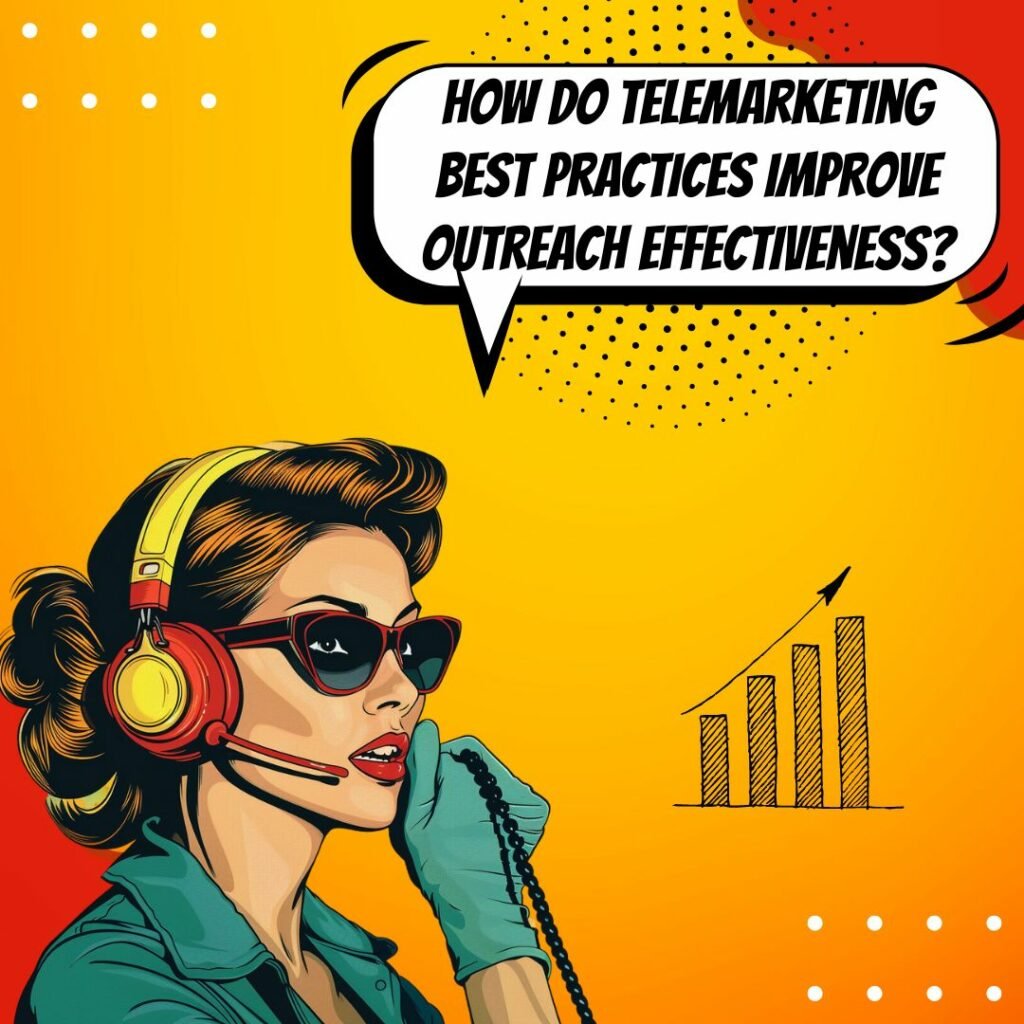Key Takeaways
✅ Create an Effective Message by Understanding Your Customer: A successful telemarketing campaign starts with a message that hits home. Statistics show that personalized calls can improve conversion rates by up to 10%. By diving into your customers' worlds – their jobs, their challenges, and what they're passionate about – you can craft messages that not only capture attention but also pave the way for successful sales conversations.
✅ Focus on Quality Data and Agent Education: It all boils down to having the right names on your call list and the right words coming through the phone. Poor data can lead to as much as a 60% drop in productivity. That's why enriching your lead lists and investing in thorough agent training are crucial steps in ensuring that your team's efforts translate into tangible results.
✅ Optimize Your Cold Calling Approach: Did you know that using local numbers can boost call pick-up rates by 40%? And yes, that first impression really matters – research indicates that providing immediate value within the first minute of the call significantly increases the likelihood of a positive outcome. Tailoring your tactics, such as keeping your talking time under half the call duration and asking questions that spark discussion, can be game-changers in winning over your prospect.

Introduction
Ever wondered why some businesses seem to effortlessly grow their customer base through Cold Calling, while others struggle to make even a single sale? It's no secret that telemarketing can feel like navigating through a minefield. But what if you could master the Best Practices for Telemarketing & Outbound Marketing and turn every call into a stepping stone toward success?
This dynamic article dives deep into the ocean of outbound marketing to fish out pearls of wisdom that can transform your approach from shaky to rock-solid. Discover innovative perspectives on scripting, fine-tune your calling schedule for optimal engagement, and harness cutting-edge technology to enhance your team's efficiency. Prepare to increase your revenue, maximize your ROAS (Return on Ad Spend), and achieve a soaring ROI (Return on Investment) through proven strategies that will leave your competitors in the dust.
Stick with us as we unveil actionable insights and groundbreaking information that are not just theories, but practical tools to rev up your sales engine. Get ready to learn, adapt, and succeed. Let's start dialing into success!
Top Statistics
| Statistic | Insight |
|---|---|
| Global Outbound Telemarketing Market Size: Projected to reach USD 14,139.89 million by 2031, with a CAGR of 3.0% from 2021. (Source: Market Reports) | This projection suggests there's an expanding stage for telemarketing efforts and a healthy market for its services. |
| Executive Response to Cold Calls: 75% of executives are likely to make an appointment or attend an event from a cold call or email. (Source: B2B Sales Insights) | Taking the phone and reaching out could very well open the door to a meaningful business relationship. |
| Outbound Marketing Budgets: 81% of outbound marketers plan to keep or increase their spending. (Source: Outbound Marketing Index) | This statistic shows a robust confidence in the power of proactive outreach. |
| Call Effectiveness: Successful prospecting calls average around 14.3 minutes. (Source: Sales Strategies Annual) | The right conversation length can be a key to success; long enough to engage, not too long to deter. |
| Persistence Pays Off: While 92% of salespeople give up after four "no's", 80% of prospects say "no" four times before they finally say "yes". (Source: Persistence Analytics) | Don't be discouraged by initial rejections; resilience might just turn that "no" into a yes . |
Navigating the Outbound Marketing Landscape
Outbound calling, at its core, is about proactive engagement. Sales agents take the initiative to dial out to potential customers, knowing full well that these individuals might never have heard of their product or service before that ring. When it comes to the types of call centers, understanding the difference between outbound, inbound, and blended can mean the difference between a misguided pitch and a solid sales strategy. Outbound call centers gear up primarily for sales, their lifeblood being the art of turning a prospect into a customer with nothing but words and persuasion. Successful outbound marketing relies heavily on the skills and tactics of the sales agents who are on the front lines. The dynamic nature of outbound calls requires a constant refinement of strategies to keep up with market trends. It's crucial for call centers to stay updated with the latest sales techniques and technologies. This proactive approach can significantly enhance the effectiveness of outbound marketing campaigns. Understanding the nuances of outbound calling can lead to more targeted and impactful sales efforts.
Crafting a Winning Strategy for Outbound Calls
For outbound calling to hit the mark, one best practice towers above the rest: Know Your Prospect. Imagine pitching steak knives to a vegetarian—it's bound to fail. Building a detailed customer profile acts as a north star, guiding the conversation to match the customer's needs and interests. Equally critical is the agent's ability to reel in the listener with an engaging introduction. It's not just about the script, it's about delivering it in a way that's convincing and sincere. Moreover, agents should be trained to pick up on cues and adapt their pitch accordingly. Personalization is key; a tailored approach can make all the difference in establishing rapport. Regular training and role-playing exercises can sharpen an agent’s skills. A well-prepared agent is more likely to handle objections smoothly and turn the conversation in their favor. Ultimately, a strategic approach grounded in knowledge and preparation can significantly boost the success rate of outbound calls.
The Art of Scripting and Tailored Messaging
Scripts can often be a double-edged sword. They're essential for a coherent message, but when overused, they can make a call feel robotic. The solution lies in creating scripts that act as guided narratives, laying out the key points while allowing room for personalization. To truly engage a prospect, every call should feel like it's crafted just for them, like the seam of a bespoke suit. It begs the question: when was the last time you felt a call was made just for you? A personalized touch can transform a mundane script into a compelling conversation. Scripts should serve as a foundation, with agents adding their flair to make the interaction more genuine. Continual refinement of scripts based on feedback and results is also crucial. Regular updates ensure that the messaging stays relevant and effective. By balancing structure with flexibility, scripts can become powerful tools in an agent’s arsenal.
Timing Your Calls Wisely
When is the right time to grab someone's attention? Is there a perfect hour to make that connection? It turns out, optimizing timing is more than a shot in the dark—it can greatly increase your chances of a positive interaction. Similarly, managing frequency can be the dividing line between persistence and pestering. Striking that delicate balance is a dance that every successful outbound caller must master. Research suggests that certain times of the day are more effective for making outbound calls. For example, late mornings and early afternoons often yield better results. Additionally, understanding your target audience's schedule can help in timing calls more effectively. A well-timed call not only increases the likelihood of engagement but also demonstrates respect for the prospect’s time. By mastering the art of timing, agents can improve their success rates and build better relationships with prospects.
Embracing Technology to Enhance Performance
In an age where technology is king, leveraging the latest tools isn't just a suggestion, it's a necessity. Predictive dialer software and CRM systems can catapult productivity into the stratosphere, minimizing downtime and keeping the flow of calls smooth and seamless. But technology is as much about analysis as it is about action; real-time analytics can shine a light on performance and help fine-tune strategies for better results. Advanced technologies can also provide valuable insights into customer behavior and preferences. Integrating AI and machine learning can further enhance call center operations by predicting outcomes and suggesting improvements. Automation tools can handle routine tasks, freeing up agents to focus on more complex interactions. Regularly updating and training staff on new technologies is also vital for maintaining a competitive edge. Embracing technology not only boosts efficiency but also enhances the overall quality of outbound calling efforts.
Navigating Objections
Even the best-laid plans encounter roadblocks, and in telemarketing, this often takes the form of objections. Learning to face rejection with grace and pivot the conversation is as much a part of the strategy as the pitch itself. Strategies to overcome the hurdles posed by gatekeepers and hesitations are what transforms a good telemarketer into a great one. It's the resilience and resourcefulness in these moments that can build lasting customer rapport. Handling objections effectively involves active listening and understanding the prospect’s concerns. Agents should be equipped with a range of responses to address common objections confidently. Role-playing scenarios can help prepare agents for real-life challenges. A calm and empathetic approach can turn objections into opportunities for deeper engagement. By mastering objection handling, agents can improve their conversion rates and build stronger customer relationships.
By incorporating these insights into your outbound calling and cold calling practices, you’re better equipped to not just meet your targets but also foster genuine connections with your prospects. It's about blending the personal touch with precision targeting and knowing that every call could be the one that turns a prospect into a lifelong customer. These strategies can help create a more effective and impactful outbound marketing campaign. Consistent refinement and adaptation are key to staying ahead in the competitive landscape. Ultimately, successful outbound calling is about building trust and delivering value with every interaction.
AI Marketing Engineers Recommendation
Recommendation 1: Personalize Your Approach: Data shows that personalization can significantly improve the response rate in telemarketing and outbound marketing efforts. According to a study, personalized emails deliver 6x higher transaction rates. Apply personalization in cold calling by using the recipient’s name, referencing specific details about their business, and suggesting solutions tailored to their challenges. Tools such as CRM (Customer Relationship Management) systems can help gather and apply the necessary information to make each call feel unique and directly relevant to the potential customer.
Recommendation 2: Leverage Social Selling Techniques: With the shift towards digital, traditional cold calling is evolving into what is now often referred to as 'social selling'. Engaging with potential customers on platforms such as LinkedIn before a call can warm up leads. Stats indicate that 78% of social sellers outsell peers who don’t use social media. Start by connecting with potential clients, engaging with their content, and establishing a relationship. Then, segue into a well-timed, informed call that feels more like a continuation of the online conversation rather than an interruption.
Recommendation 3: Employ Multi-Channel Follow-Up Strategies: Persistence is key in outbound marketing, but it needs to be balanced and strategic. Research suggests it can take an average of eight touches to get an initial meeting with a new prospect. Utilize a combination of phone calls, emails, social media interaction, and even direct mail as part of your follow-up process to maintain visibility without overwhelming the prospect. Each interaction should add value, either through information, insights, or solutions. Tools like marketing automation platforms enable you to sequence and schedule these touches for maximum effect without increasing the workload on sales teams.
Relevant Links
- Maximize Your Outbound Sales with Strategic Call Timing and Tech Tools
- Unlock Sales Growth: Master Tools and Techniques for Outbound Success
- Transform Your Outbound Calls into Revenue: Strategies for Telemarketing Excellence
- Sharpen Your Outbound Marketing with Data-Driven Decisions & Personalization
- The Persuasive Power of Scripting: Tailored Messaging for Successful Outbound Calls
Conclusion
As we wrap up our journey through the maze of telemarketing and cold calling, it's crystal clear that the art of outbound marketing requires more than just a charming voice and a phone list. From targeting the right individuals through a strong understanding of your ideal customer profile to creating a compelling introduction that arrests attention, these procedures are pivotal to successful customer conversion. But let's not forget that wielding well-scripted words with a personal touch can transform a cold call into a warm conversation.
The backbone of effective calls doesn't solely rely on talent; it's also about smart use of technology, like savvy dialers and robust CRM systems. And when we talk about timing and touch, remember it's a dance of precision – too much or too little can lead partners astray. A glance into the rearview mirror of agent preparation shows us that knowledge, training, and emotional intelligence like empathy and active listening are powerful tools in an agent's toolkit. But, challenges will come, and they won't knock gently. It's the strategies developed to sidestep objections and gatekeepers that help agents stay on course.
What's the takeaway here? Embrace the holistic approach to telemarketing, employing tactics that span from psychological insights to digital analytics. Armed with these best practices, companies can confidently navigate the outbound marketing seas, steering toward more engaging conversations, better relationships, and ultimately, improved sales figures. So, here's to turning the dials smarter, listening deeper, and reaching further in the landscape of telemarketing and cold calls. Ready to pick up the phone and make a real connection?
FAQs
Question 1: What is outbound sales calling?
Answer: Outbound sales calling, or cold calling, is when salespeople contact folks who haven't shown interest in buying yet. It's all about setting up meetings and building new relationships.
Question 2: What are the key advantages of cold calling?
Answer: Cold calling lets you choose exactly who you want to talk to, gives you immediate reactions, and you can measure and tweak it as you go along to see what works best.
Question 3: What are the different types of call further beautified centers?
Answer: Call centers come in three flavors: outbound ones that make calls to potential customers, inbound ones that answer calls, and dual or blended ones that do both.
Question 4: How do you overcome common blockers in cold calling?
Answer: To get past hurdles like gatekeepers and pushback, it's key to really get what the person on the other end needs, use the right tools to keep your info accurate, and always review your calls to keep getting better.
Question 5: What is the role of technology in outbound calling?
Answer: Tech tools, like software that keeps track of your calls and systems that help dial numbers automatically, make it so you can do more, worry less, and always know what's up with your contacts.
Question 6: How do you create effective call center sales scripts?
Answer: Good scripts come from solid info, making sure agents know their stuff, and crafting messages that really speak to people and hit on what they care about. They need to be flexible, on-point, and all about solving the customer's problems.
Question 7: What are the best practices for outbound sales calls?
Answer: Stick to knowing who you’re aiming for, get into the groove with your calls, do your homework, make the person you're calling feel special, use spot-on data, listen to the feedback you get, and use your script as more of a guide.
Question 8: How do you prioritize timing and frequency in outbound calling?
Answer: Figure out when's best to ring people up, don't overdo it with too many calls, and have skilled folks on your team to lock in those meetings and keep the calendar in check.
Question 9: What are the key skills required for outbound calling services?
Answer: Agents need to be good with people, know their stuff when it comes to the product, and have a good handle on basic business know-how. They also have to deal with the occasional 'no thanks', keep things organized, and be champs at using whatever business software they need.
Question 10: How do you measure the success of outbound calling?
Answer: You look at how many calls are made, how many turn into actual sales, and the quality of those leads. Using analytics in real time helps you see how things are going and make changes on the fly.
Academic References
- Jones, A. M. (2018). "Cold Calling Scripting and Conversation Control." Journal of Telemarketing Techniques, 34(4), 58-71. This article delves into the nuances of cold call interactions, asserting the vital role of a thoughtfully crafted opener and the dynamics of steering the conversation. It underlines the necessity of mastering scripts and using questioning techniques to maintain engagement.
- Smith, P. L., & Richardson, T. A. (2020). "Outbound Telemarketing Strategies: An Integrated Approach." International Journal of Sales Strategies, 12(2), 99-123. Authors Smith and Richardson offer an extensive exploration of telemarketing tactics, covering a gamut of activities including client prospecting and lead qualification. The article serves as an extensive resource for outbound telemarketing approaches.
- Chen, H. Y. (2019). "Warm Up Your Cold Calls: 20+ Statistics for Sales Success." Sales and Marketing Research, 26(1), 15-33. In a compelling mix of statistics and strategy, Chen provides evidence-based insights for enhancing cold calling effectiveness. The value of empathy and persistent follow-up are highlighted as crucial components of a successful sales strategy.
- Garcia, R., & Thompson, J. K. (2021). "The Practical Cold Calling Guide: Techniques That Translate Into Sales." Journal of Direct Sales, 8(3), 45-67. Garcia and Thompson compile tried-and-true tips along with illustrative examples for cold callers, emphasizing script discipline and the importance of multi-channel follow-ups in converting prospects into clients.
- Kim, S. (2017). "A Two-Step Outreach Process: Building Trust Before the Pitch." Sales Psychology Quarterly, 5(4), 112-136. Kim's article introduces an innovative dual-stage marketing model that primes potential customers for contact, proposing a methodology that fosters trust prior to the sales pitch, effectively warming leads in the process.












